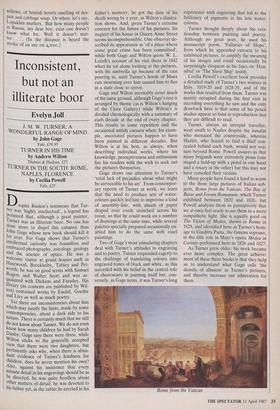Inconsistent, but not an illiterate boor
Evelyn Jo11
J. M. W. TURNER: A WONDERFUL RANGE OF MIND by John Gage
Yale, £19.95
TURNER IN HIS TIME by Andrew Wilton
Thames & Hudson, £25
TURNER IN THE SOUTH: ROME, NAPLES, FLORENCE by Cecilia Powell
Yale, £25
Despite Ruskin's testimony that Tur- ner was 'highly intellectual', a legend has persisted that, although a great painter, Turner was an illiterate boor. No one has done more to dispel this calumny than John Gage whose new book should kill it for ever. For Gage shows that Turner's intellectual curiosity was boundless and embraced photography, astrology, geology and the science of optics. He was a welcome visitor at grand houses such as Harewood, Brocklesby, Tabley and Pet- worth; he was on good terms with Samuel Rogers and Walter Scott and was ac- quainted with Dickens and Faraday. His library (its contents are published by Wil- ton) contained works by Euclid, Goethe and Livy as well as much poetry. Yet there are inconsistencies about him Which may justify the hints, made by some contemporaries, about a dark side to his nature. There is certainly much that we still do not know about Turner. We do not even know how many children he had by Sarah Danby; Gage says there were three, while Wilton sticks to the generally accepted view that there were two daughters, but Pertinently asks why, when there is abun- dant evidence of Turner's fondness for Children, does he never mention his own? Also, against his insistence that every minute detail in his engravings should be as he directed, he was quite heedless about Other matters of detail: he was devoted to his father yet, in the tablet he erected in his father's memory, he got the date of his death wrong by a year, as Wilton's illustra- tion shows. And, given Turner's extreme concern for the future of his pictures, his neglect of his house in Queen Anne Street seems incomprehensible. One observer de- scribed its appearance as 'of a place where some great crime has been committed', while both Gage and Wilton quote W. L. Leitch's account of his visit there in 1842 when he sat alone looking at the pictures, with his umbrella up because of the rain pouring in, until Turner's horde of Manx cats swarming over him caused him to flee in a state close to terror.
Gage and Wilton inevitably cover much of the same ground, although Gage's text is arranged by theme (as is Wilton's hanging of the Clore Gallery) while Wilton's is divided chronologically with a summary of each decade at the end of every chapter. This results in some repetition and the occasional untidy caesura when, for exam- ple, associated pictures happen to have been painted in different decades. But Wilton is at his best, as always, when describing individual. works', where his knowledge, perceptiveness and enthusiasm fire his readers with the wish to seek out the pictures themselves.
Gage draws our attention to Turner's 'total lack of prejudice about what might be serviceable to his art'. From contempor- ary reports of Turner at work, we learn that the need to produce sets of water- colours quickly led him to improvise a kind of assembly-line, with sheets of paper draped over cords stretched across his room, so that he could work on a number of drawings at the same time, while several palettes specially prepared occasionally en- abled him to do the same with easel paintings.
Two of Gage's most stimulating chapters deal with Turner's attitudes to engraving and to poetry. Turner responded eagerly to the challenge of translating colours into engraved tones of black and white, as this accorded with his belief in the central role of chiaroscuro in painting itself but, con- versely, as Gage notes, it was Turner's long experience with engraving that led to the brilliancy of pigments in his late water- colours.
Turner thought deeply about the rela- tionship between painting and poetry. Although no great poet, he used his manuscript poem, 'Fallacies of Hope', from which he appended extracts to his exhibited pictures, to amplify the meaning of his images and could occasionally be surprisingly eloquent as his lines on 'Han- nibal' or 'The Slave Ship' testify.
Cecilia Powell's excellent book provides a detailed study of Turner's two winters in Italy, 1819-20 and 1828-29, and of the works that resulted from them. Turner was mainly occupied during the first visit in recording everything he saw and the only drawback here is that some of his pencil studies appear so faint in reproduction that they are difficult to read.
Turner, always an intrepid traveller, went south to Naples despite the banditti who menaced the countryside, whereas Hazlitt, who feared to find a thief con- cealed behind each bush, would not ven- ture beyond Rome. Powell assures us that many brigands were extremely pious (one staged a hold-up with a pistol in one hand and a rosary in the other) but this may not have consoled their victims.
Many people have found it hard to warm to the three large pictures of Italian sub- jects, Rome from the Vatican, The Bay of Baiae and Forum Romanum, which Turner exhibited between 1820 and 1826, but Powell analyses them so perceptively that we at once feel ready to see them in a more sympathetic light. She is equally good on The Vision of Medea, shown in Rome in 1828, and identified here as Turner's hom- age to Giuditta Pasta, the famous soprano, in the title role in Mayr's opera Medea in Corinto performed here in 1826 and 1827.
As Turner grew older, his work became ever more complex. The great achieve- ment of these three books is that they help us to understand what Gage calls 'the density of allusion' in Turner's pictures, and thereby increase our admiration for them.
Rome from the Vatican
























































 Previous page
Previous page